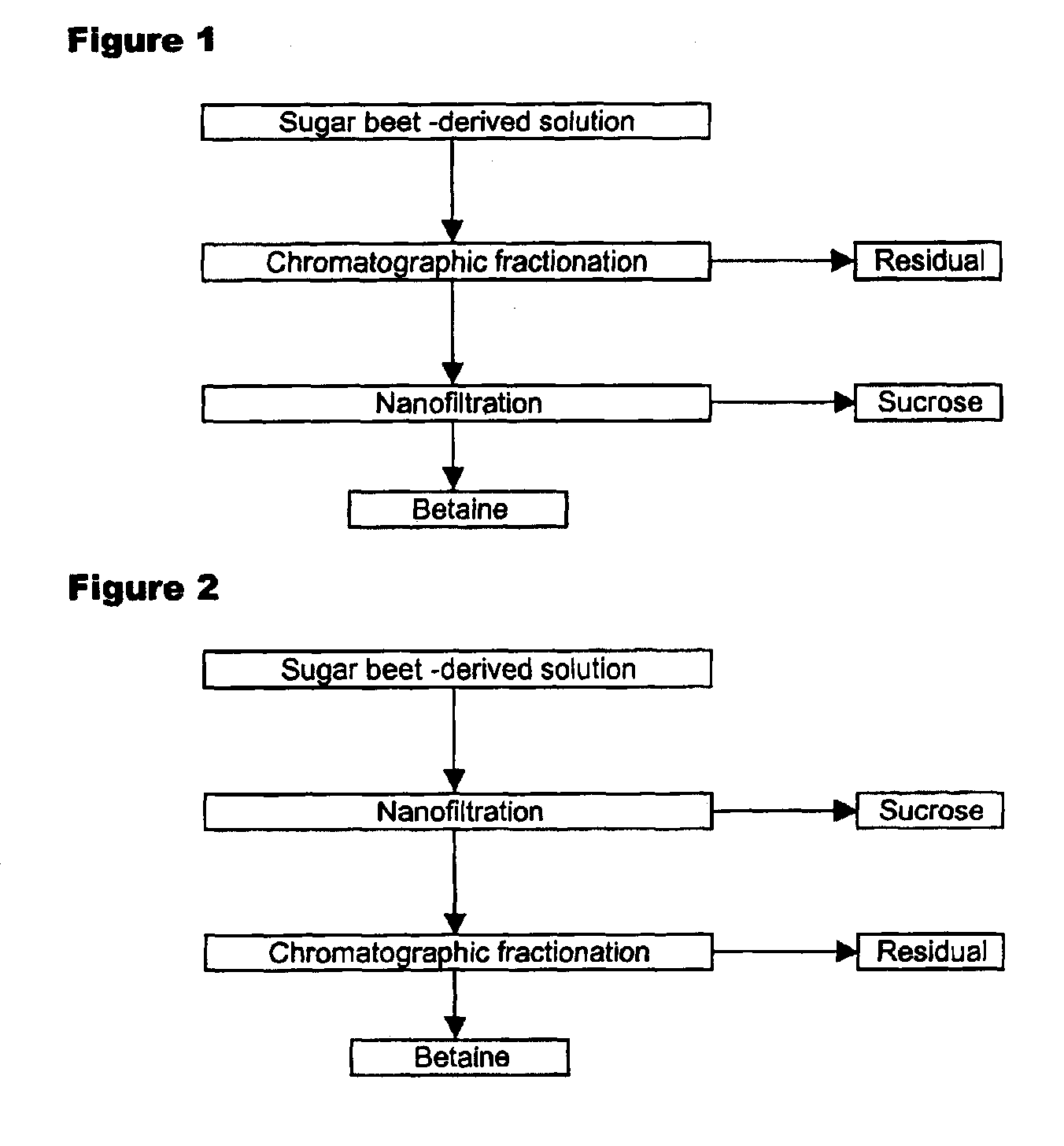Process for recovering betaine
a technology of beet extract and process, which is applied in the field of separation process for recovering beet extract, can solve the problems of not being able to achieve the equilibrium of casup>2+/sup> form of resin and the cation composition of the mobile phase, and the combination of chromatography and nanofiltration to recover beet extract from sugar beet-derived solutions has not been disclosed or suggested, so as to improve the purity and/or yield of the final b
- Summary
- Abstract
- Description
- Claims
- Application Information
AI Technical Summary
Benefits of technology
Problems solved by technology
Method used
Image
Examples
example 1
Separation of Betaine and Sucrose by Nanofiltration
[0125]This example illustrates the separation of betaine and sucrose using various nanofiltration membranes. The feed solution used for the nanofiltration was a solution made from sucrose and betaine crystals, containing 50% betaine and 50% sucrose. The feed had a pH of 9.2 and DS of 12.7%. The equipment used for the nanofiltration was DSS Labsta M20-filter. The nanofiltration was carried out using total recycling mode filtration (constant feed concentration). The nanofiltration pressure was 30 bar, the cross-flow velocity about 0.7 m / s and the temperature 65 to 70° C. The membranes used for the nanofiltration are set forth in Table 1 below.
[0126]Table 1 shows the content of betaine (%) in the permeate based on chromatographic analysis (the sum of sucrose and betaine is 100%).
[0127]
TABLE 1Content of betaine in the permeate obtained from the nanofiltrationof a solution containing betaine and sucroseThe content of betaine in theMembra...
example 2
Fractionation of Beet Molasses by Chromatography
[0129]A pilot scale sequential SMB chromatographic equipment was used in the fractionation. The equipment consisted of 6 columns in series, a feed pump, circulation pumps and a pump for eluent water as well as inlet and product valves for the process streams. Each column had a height of 4.0 m and a diameter of 0.111 m. Columns were packed with a strong acid gel type cation exchange resin in Na+ -form, mean particle size of the resin was 0.36 mm and DVB-content 5.5%. Temperature of the columns was 80° C. and water was used as eluent. Prior to chromatographic separation, the beet molasses was carbonated with sodium carbonate (dosage 1.5% on dry substance, temperature 60° C. and reaction time 3 h) and filtered with Seitz filter press using Kenite 300 as filter aid (precoat 1 kg / m2, body feed 1.0% on dry substance).
[0130]Chromatographic separation was carried out in 9-step sequence as follows (operations a, b and c take place simultaneousl...
example 3
Nanofiltration of a Betaine-Rich Sucrose Fraction Obtained from Chromatographic Separation
[0151]The betaine-rich sucrose fraction containing 80.9% sucrose and 14.5% betaine obtained according to Example 2 was subjected to nanofiltration.
[0152]The nanofiltration was carried out using the same equipment as in Example 1. The nanofiltration feed had a DS of 15.6 g / 100 ml, the nanofiltration temperature was 70° C. and the nanofiltration pressure was 28 bar. The nanofiltration membranes were Desal-5 DL and Desal-5 DK. The content of betaine in the nanofiltration permeate obtained from the nanofiltration with Desal 5DL was 65.4% and the content of sucrose in the permeate was 31.1% on DS. When using Desal-5 DK as the nanofiltration membrane, the content of betaine in the nanofiltration permeate thus obtained was 61.2% and the content of sucrose in the permeate was 31.3% on DS.
PUM
| Property | Measurement | Unit |
|---|---|---|
| pore size | aaaaa | aaaaa |
| molar mass | aaaaa | aaaaa |
| particle size | aaaaa | aaaaa |
Abstract
Description
Claims
Application Information
 Login to View More
Login to View More - R&D
- Intellectual Property
- Life Sciences
- Materials
- Tech Scout
- Unparalleled Data Quality
- Higher Quality Content
- 60% Fewer Hallucinations
Browse by: Latest US Patents, China's latest patents, Technical Efficacy Thesaurus, Application Domain, Technology Topic, Popular Technical Reports.
© 2025 PatSnap. All rights reserved.Legal|Privacy policy|Modern Slavery Act Transparency Statement|Sitemap|About US| Contact US: help@patsnap.com


